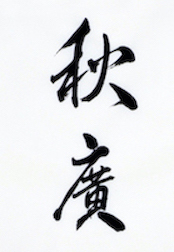
Sōshū Akihiro (相州秋広 – 相州秋廣) was Hiromitsu’s younger brother. Both of them are the leading representatives of smith workmanship of the Sagami School in the Nanbokuchō period. According to the Kotō Meizukushi Taizen (古刀銘盡大全), Akihiro was Sadamune’s disciple. He was born in the 4th year of the Shōwa era (正和, 1315). At birth, he was given the name Kurōsaburō (九郎三郎), and he died in the 5th year of the Ōei era (応永, 1398) in the 84th year of his life. Some sources note that Akihiro was Hiromitsu’s son or disciple. However, the most credible theory is that he was Hiromitsu’s younger brother and, consequently, Shintōgo Kunihiro’s son. In the Teiryo Yoji by Hon’ami Kōson (1984), compiled from the clan’s old records and received by Hon’ami Ringa from his wife, we can find some references stating that Akihiro was Yukimitsu’s son. This theory did not gain wide popularity. Most old sources assume that the master was taught by Masamune or Sadamune. Very often, Hiromitsu and Akihiro, during their active working period, were described as “those who followed Sadamune.”
The Tōken Kantei Hikketsu contains information about Akihiro being taught by Sadamune and being a very accomplished successor to Sadamune, in terms of his forging methods. In this manuscript, we also find quite rare references stating that Akihiro sometimes signed his works as “Sadamune.” This is a very strong argument in favor of the suggestion that Akihiro and Sadamune worked together, although it does not contradict the theory that Akihiro was also taught by Masamune. This could have been possible, especially in Akihiro’s early years.
According to his own rating system, published in the Nihon Tōkō Jiten (“Japanese Smiths’ Dictionary”), Fujishiro Yoshio (藤代義雄) evaluates Akihiro’s works as saijō-saku (最上作, the superior level of workmanship). In the same book, he makes a very interesting suggestion concerning the scrupulous reproduction of the teacher’s style by his disciple. In fact, a few of Hiromitsu’s and Akihiro’s works with ubu nakago (“initial shape tang”) have survived to the present day. However, all of them end with kurijiri–type tangs (“chestnut shape”), while Masamune’s and Sadamune’s swords have the so-called sword-like tang: kengyō (剣形). It is suggested that this type of tang, which became a distinctive mark of the epoch, was first designed and used by Masamune. Therefore, both Hiromitsu and Akihiro failed to follow the traditions of their teachers regarding tangs. In other words, they did not make them as kengyō, if we assume that the ubu tangs of some of Masamune’s and Sadamune’s swords are original.
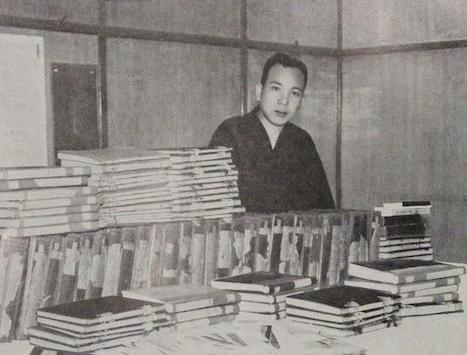
Figure 1. Fujishiro Yoshio.
For example, the Umetada Meikan (埋忠銘鑑) contains a lot of tangs’ oshigata. It is these three smiths—Masamune, Sadamune, and Gō Yoshihiro—who created the most tangs of the kengyō type, with or without their signatures. Probably, the kengyō method of shortening tangs was developed right in the Umetada clan and treated as a distinct feature of these masters’ works. We know that it was Shigenaga (重長) who shortened the nakago and made kinzōgan-mei in the Umetada clan. Umetada Shigenaga, more widely known under his nickname Jusai (寿斎), was named Hikoemon at birth. He was the son of Umetada Myōshin (埋忠明真). It is highly possible that he was the originator of the method of shortening the nakago into the kengyō type. Consequently, this feature appeared much later and has never been connected with Akihiro’s and Hiromitsu’s smithing works.
Therefore, when we discuss which masters followed their teachers’ traditions, it is worth noting that modern researchers agree that Hiromitsu was truly Shintōgo Kunihirō’s son. This means that Akihiro, as well as his younger brother, was also Shintōgo Kunihiro’s son. Directly representing the founders of the Sagami School, they were likely to preserve the style of Shintōgo (Kunimitsu and Kunihiro) tangs in their works. It is necessary to recall that most surviving works have a lot of ubu nakago, and almost all of them are kurijiri or ha-agari-kurijiri.
Akihiro’s dated works are from the following eras: Jōji (貞治, 1362–1368), Ōan (応安, 1368–1375), and Eiwa (永和, 1375–1379). Among the dates indicated, the earliest work is a tantō from 1357, and the latest one is a ko-wakizashi from 1387. We should specifically mention the surviving katana dated 1392 and signed “Sōshū-jū Akihiro,” which has Jūyō Bunkazai status. Akihiro always signed his works as “Sōshū-jū Akihiro” (相州住秋廣), using the name of Sōshū Province, instead of Sagami. He always dated his works. In addition, his style of dating and signing differs from those of Hiromitsu and Sadamune. Akihiro added only the year of manufacture, without denoting the day and the month. For example, Ōan san (応安三) is the 3rd year of the Ōan era (1370). Moreover, there was an unusual feature in the way the master wrote the kanji “Hiro” (廣) in his smith name. In the tang, Akihiro always invariably made a small stroke above the top line of the 广 radical in a horizontal direction. We should recall that Hiromitsu always made it as a small vertical stroke.
Dating without gappi (a month, a day—月日) is supposed to be typical for Akihiro. Early on, Akihiro’s swords that were signed and dated with the year, the month, and the day—nen-gappi (年月日)—were thought to be counterfeit.
<.....> When we analyze this form of the master’s signature, it is worth mentioning that of the 24 surviving works of Akihiro (Jūyō and higher):
- 5 swords were not signed and dated. Three of them have an ubu nakago, and another two are shortened wakizashi and katana, attributed as “Den Akihiro” with Jūyō Bunkazai status;
- 11 swords were signed and dated in a way that is supposed to be classic for Akihiro (i.e., “Sōshū-jū Akihiro” plus the year of manufacture, without indicating the day and the month);
- 4 swords were signed in the usual manner—“Sōshū-jū Akihiro”—and dated with the manufacturing year, day, and month;
- 1 sword was signed “Sagami (no) kuni . . .” with a full date (nen-gappi) indicated;
- 2 swords were signed “Sōshū-jū Akihiro,” without a date; and
- 1 sword was signed “Akihiro,” without a date.
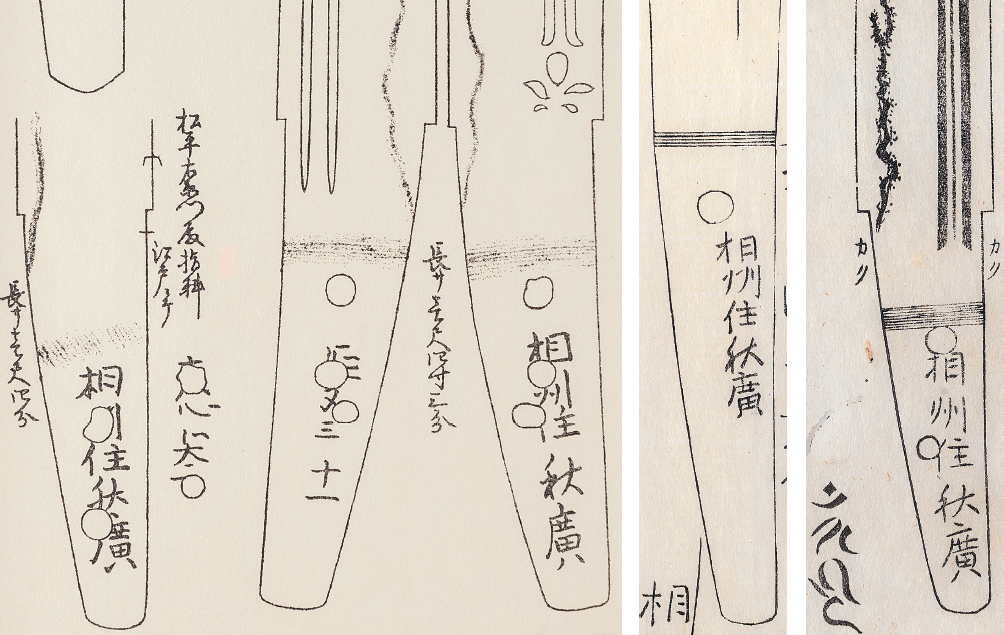
Figure 2. Akihiro’s signatures on ko-wakizashi. Umetada Meikan, p. 47/2; Kotō Meizukushi Taizen, Volume 8, p. 24/1, and Volume 7, p. 20/2.
Thus, based on the analysis of surviving works, we could say that the master varied the style of signing and dating his works quite a lot, as Hiromitsu did. Primarily, regarding Akihiro, it is necessary to avoid expressing any categorical opinions, such as “he never signed . . .” and “he always dated . . .” Making a reference to his characteristic, typical manner of signing and dating is more accurate, because it has some exceptions. Surely, today, it is not known which quantitative material was the basis of experts’ conclusions in the past. Nevertheless, we should remember that nowadays we can analyze almost all surviving works of a particular master. Yet we can discuss the reasons for such variety only in terms of hypotheses, because we have extremely poor data confirmed by documents. Akihiro possibly reproduced the style of his teachers and elder masters, which extended to copying their signature style. That is, the master was likely to sign and date his earlier works in his teacher’s style. This is proved by earlier dating in the nen-gappi (年月日) style. Later, he changed his style of signing and dating to his own characteristic one. It is necessary to take into account his extended period of activity and his long life, during which he could have changed both his forging techniques and his signature styles. Moreover, concerning Akihiro, there is no evidence that any of his disciples signed the teacher’s works, or that Akihiro signed his disciples’ works with his own hand. Therefore, questionable works or signatures cannot be considered his disciples’ works. These works should be treated as counterfeits.
Summing up all of the above-mentioned information about Akihiro’s artistic endeavors, we should note that old sources gave him much more attention than current ones do. Some of them—the Tōken no Shin Kenkyū (刀剣の新研究), for example—call him one of the central figures of the Sagami School, continuing the genealogical line from Shintōgo Kunimitsu through Sadamune and Akihiro. Moreover, one significant fact has fallen out of favor among general views and is often ignored by researchers of the Sagami School. It concerns another smith who signed his works as Akihiro during the early period of the Sagami School. In particular, Soten Uchida notes the existence of a sword with an inscription “Sōshū-jū Akihiro” dated the 6th month of the 2nd year of the Shōan era (正安, 1300). That is, the existence of a first generation of Akihiro, who was Yukimitsu’s son, seems possible and logical for the Sagami School’s structure. In this case, Akihiro’s line dates back directly to Yukimitsu. Different generations of masters were taught by Masamune, Sadamune and then, possibly, by Hiromitsu.
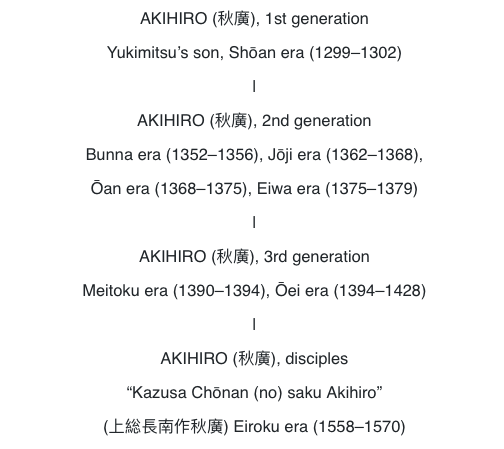
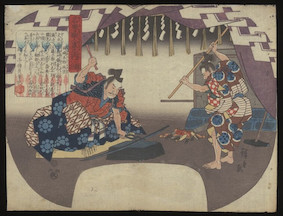
Akihiro’s works are, in general, considered hardly distinct from Hiromitsu’s. They feature the following:
Sugata: Very little surviving tachi and katana; no signed works among the surviving ones. Most works are ko-wakizashi, 32–34 cm long with mitsu-mune, a wide mihaba, a slight hira-niku, a thin kasane, and a small sori (sakizori). His tachi-sugata is slender, has a high shinogi, and has a steep iori-mune.
Jitetsu: Ō-itame hada with good-quality forging. The steel has a bluish-black color but with a whitish hue on top of it.
Hamon: Ō-midare, mixed with large nie, many kinsuji, intensive inazuma, sunagashi, very intensive tobiyaki, and hitatsura (皆焼). Akihiro’s hitatsura, as opposed to Hiromitsu’s, spreads vertically.
Bōshi: The midare-komi is often symmetrical, with a long kaeri; sometimes there is a short, asymmetrical kaeri.
Horimono: As with Hiromitsu’s works, those of Akihiro exhibit horimono of the bō-hi type, the bō-hi type with soe-bi, or the futasuji-hi type, often accompanied by complex engravings of various Shinto symbols and signs.
Nakago: It is identical to the one that occurs in Hiromitsu’s swords, but with the signature in the variant “ Sōshū-jū . . . “, not “Sagami (no) Kuni . . .” Akihiro always wrote the kanji “Aki” in a cursive style, and the top stroke above the kanji “Hiro” in the form of a horizontal line at a little oblique angle. The signatures whose kanji “Aki” are written in “printed” form must be considered false.
Most sources are too simplistic in describing Hiromitsu’s and Akihiro’s forging style and are satisfied with stating that they have almost no differences. But they do have, and these differences are very distinct. The most significant one that we note when comparing “living” works by Akihiro and Hiromitsu manifests in the sugata. Hiromitsu’s swords are more elegant than Akihiro’s. This is explained by a relatively thinner mihaba and slightly “calmer” hitatsura. That is, Akihiro’s swords have a more “aggressive” look than Hiromitsu’s. The second difference is the direction the hitatsura tends to spread: Akihiro’s spreads vertically (along the blade), and therefore the hamon looks wavier. On the contrary, Hiromitsu’s hitatsura spreads horizontally, toward the ha line. The third difference is the existence of clear signs of uzumaki-hada (渦巻—a characteristic pattern of the hada in the form of “whirlpools”) in Akihiro’s works. The fourth difference is the length of the nakago. In general, the tangs of Akihiro’s ko-wakizashi are slightly shorter than those of Hiromitsu. The characteristics of Akihiro’s tangs are very similar to those of the Hasebe School. Finally, the fifth difference, which is Akihiro’s core feature, is the forging quality of the hada. Some books state that masters of this specific generation of the Sagami School always executed poor-quality forging in general. Nevertheless, certain works had high-quality characteristics that were as good as the classic works. In general, though, the quality of Hiromitsu’s and Akihiro’s ji-hada is lower than that of the previous generation of Sōshū masters.
<.....> The Nanbokuchō period saw a little revolution happening in short sword making, but it had already started at the end of the Kamakura period, due to the creativity of the Sagami School masters and their disciples. Affected by new requisitions from actual battles, the sugata of long swords, as well as those of tantō, started to change at that time. The first signs of tantō lengthening could already be seen in Yukimitsu’s works. Chapter 4, dedicated to this master, presents as an example a short sword, Jūyō Tōken Yukimitsu. Due to the length of the nagasa (34.0 cm), it was classified as a wakizashi, although its form is a tantō, with all corresponding proportions slightly larger than classic ones. The same process, but with more expressive features, is visible in Sadamune’s works. In addition to a lengthened nagasa, a curve (sori) appeared, and the sugata was changed. The process ended with the emergence of an actual new short sword called a ko-wakizashi (小脇指), which took its well-known final form in the works of Hiromitsu, Akihiro, and Hasebe.
These particular masters developed a certain standard form of ko-wakizashi, which characterized the Nanbokuchō period. Later, in the Tokugawa period, the maximum length of the nagasa for this type of sword was determined to be 45 cm. The tangs of these swords are disproportionally short, in comparison with those of tantō, although their length is the same, even with an apparently longer blade nagasa. The lengths of the tangs (nakago nagasa), among all surviving signed ko-wakizashi (Jūyō and Tokubetsu Jūyō), measure as follows:
Hasabe Kuninobu, average nakago nagasa = 9.2 cm
Hasabe Kunishige, average nakago nagasa = 9.5 cm
Sōshū Akihiro, average nakago nagasa = 9.6 cm
Sōshū Hiromitsu, average nakago nagasa = 10.2 cm
Together with this feature of having a very short tang, we note a specific location for the first mekugi-ana in the works of all masters named above. It used to appear barely in the middle of a tang and a little farther from the nakago-mune. That is, we conclude that the tang length, equal to the nakago nagasa of a classic tantō, underwent no modifications when the blade itself was lengthened over the course of the Nanbokuchō period.
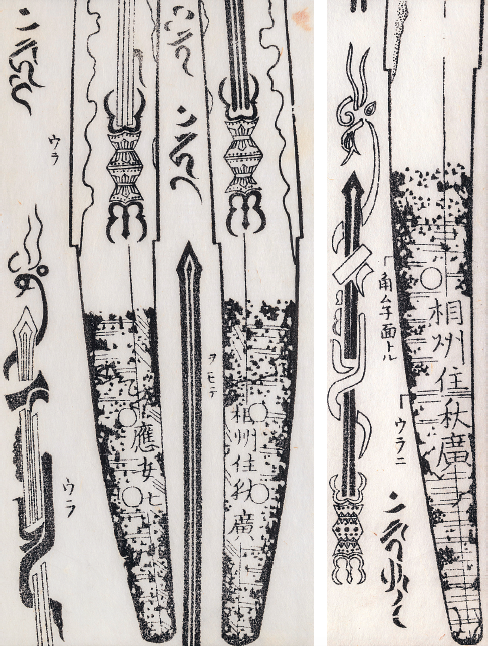
Figure 3. Oshigata of Akihiro’s long swords. Honchō Kaji Kō, 1795, Volume “Ram,” pp. 13/1 and 13/2.
<.....> Despite the fact that almost all of Akihiro’s and Hiromitsu’s long swords have lost their signatures, this does not mean that shortened works did not have any. For example, the Nihontō Kōza mentions a shortened, unsigned daitō whose attribution to Akihiro raises no doubts. The same situation can be described concerning several works by Hiromitsu. In general, however, the attribution of works by these two masters is hampered by expert opinions coming from the times of Muromachi and Edo, claiming that Akihiro’s and Hiromitsu’s daitō are extremely rare, and only ko-wakizashi have survived. Therefore, even if a long sword looks like Akihiro’s work, it is extremely difficult to get proper attribution, because experts tend to assign such swords to Masahiro or even to Tsunahiro, rather than to Akihiro.
(excerpt from Chapter 8, pp. 208-227, of the Japanese Swords: Sōshū-den Masterpieces )
Original content Copyright © 2019 Dmitry Pechalov